Sivananda Bahamas Blog
Expand Your Horizons …
Our Blog
Glory to Devi: Exploring the Divine Feminine Through the 3 Aspects of the Divine Mother
Devi or Sakti is the Mother of Nature. She is Nature itself. The whole world is Her body. Mountains are her bones. Rivers are Her veins. Ocean is Her bladder. Sun, moon are Her eyes. Wind is Her breath. Agni is Her mouth. She runs this world show." - Swami Sivananda
We are all One in essence. In the world of gross reality, the manifestations of that Oneness are multiple. This week, we celebrate the many expressions of the Divine Feminine by sharing stories of the Divine Mother as Durga, Lakshmi, and Saraswati. We do so in honor of Mother's Day, to shine a light on the breadth of a mother's reach, the nourishment inherent in her every touch, gaze, and word.
Before jumping into narratives, we must first understand the meanings behind the mythology surrounding Devi. We must ask Who is Devi? We must understand the metaphors inherent in the stories surrounding Devi. Below, you will find explanations of Devi and her manifestation as Sakti. These descriptions are excerpts from Swami Sivananda's Bliss Divine and can be found in Chapter 17 — Devi.
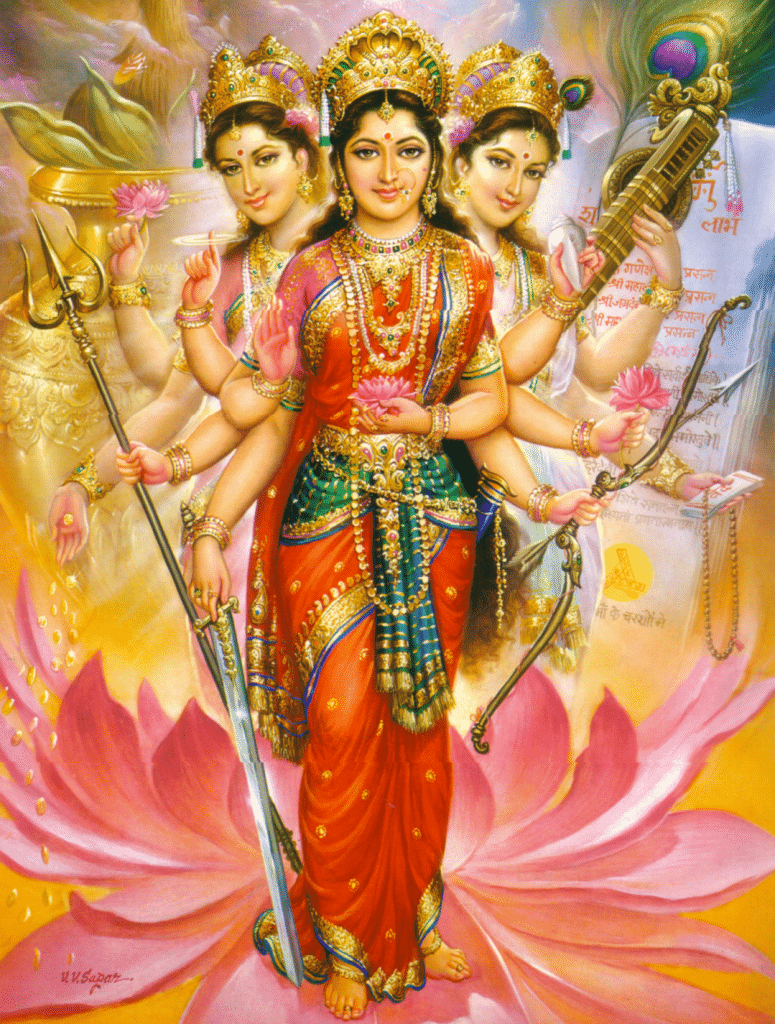 Who is Devi? An Overview of the Creatrix of the Universe
Who is Devi? An Overview of the Creatrix of the Universe
Devi or Maheswari or Parasakti is the Supreme Sakti, or power of the Supreme being. When Vishnu and Mahadeva destroyed various Asuras (demons), the power of Devi was behind them. Devi took Brahma (the god of creation), Vishnu (the god of preservation), and Rudra (the god of wind and storm) and gave them necessary Sakti to proceed with the work of creation, preservations, and destruction.
Devi is the creatrix of the universe. She is the Universal Mother. Durga, Kali, Bhagavati, Bhavani, Ambal, Ambica, Jagadamba, Kamesvari, Ganga, Uma, Chandi, Chamundi, Lalita, Gauri, Kundalini, Tara, Rajesvari, Tripura-sundari, etc., are all Her forms. She is worshipped, during the nine days of Dusserah as Durga, Lakshmi, and Saraswati.
Devi as the Manifestation of Sakti
Sakti is symbolically female; but it is, in reality, neither male nor female. It is only a force which manifests itself in various forms.
The five elements and their combinations are the external manifestations of the Mother. Intelligence, discrimination, psychic power, and will are Her internal manifestations. Humanity is Her visible form.
She lies dormant in the Mūlādhāra Chakra in the form of the serpentine power or coiled-up energy known as the Kundalini Sakti. She is at the centre of the life of the universe. She is the primal force of life that underlies all existence. She vitalises the body through the Sushumna Nadi and the nerves. She nourishes the body with chyle and blood. She vitalises the universe through Her energy. She is the energy in the sun, the fragrance in the flowers, the beauty in the landscape, the Gayatri or the Blesses Mother in the Vedas, color in the rainbow, intelligence in the mind, potency in the homeopathic pills, power in the Makaradhvaja and gold-oxide, will and Vichara Sakti in sages, devotion in Bhaktas, Samyama and Samadhi in Yogins. Vidya, Shanti, lust, anger, greed, egoism, pride are all Her forms. Her manifestations are countless.
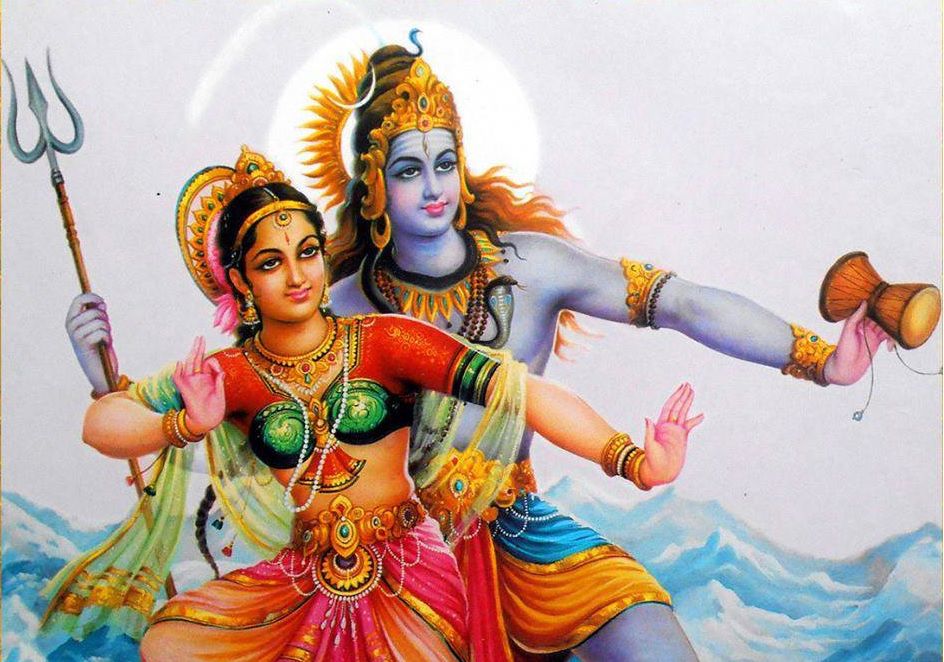
Siva and Sakti
The Supreme Lord is represented as Siva, and His power is represented as His wife—Sakti, Durga, or Kali. Mother Durga is the energy aspect of the Lord. Without Durga, Siva has no expression; and without Siva, Durga has no existence. Siva is the soul of Durga. Durga is identical with Siva. Lord Siva is only a silent witness. He is motionless, absolutely changeless. He is not affected by the cosmic play. Durga does everything.
Siva is omnipotent, impersonal, inactive. He is pure consciousness. Sakti is dynamic. The power or active aspect of the immanent God is Sakti. Sakti is the embodiment of power.
Siva and Sakti are related as Prakasa and Vimara. Sakti or Vimarsa is the power that is latent in the pure consciousness. Vimarsa gives rises to the world of distinctions. In other words, Sakti is the very possibility of the Absolute's appearing as many, of God's causing this universe. God creates this world through Srishti-Sakti, preserves through Sthiti-sakti and destroys through Samhara-sakti.
There is no difference between God and His Sakti, just as there is no difference between fire and its burning power. Sakti is inherent in God. Just as you cannot separate heat from fire, so also you cannot separate Sakti from God, the possessor of Sakti. Sakti is Brahman Itself. Siva and Sakti are one. Siva is always with Sakti. They are inseparable. Worship of Durga or Parvati or Kali is worship of Lord Siva.
The 3 Main Aspects of the Divine Mother—Durga, Lakshmi, Saraswati
The Divine Mother is everywhere triple. She is endowed with the three Guns, viz., Sattva, Rajas, and Tamas. She manifests as Will or Iccha-sakti, Action or Kriya-sakti, and Knowledge or Jnana-sakti. She is Brahma-sakti (Saraswati) in conjunction with Brahma, Vishnu-sakti (Lakshmi) in conjunction with Lord Vishnu, Siva-sakti (Mahakali or Durga) in conjunction with Lord Siva.
Saraswati is cosmic intelligence, cosmic consciousness, cosmic knowledge. Lakshmi does not mean mere material wealth like gold, cattle, etc. All kinds of prosperity, glory, magnificence, joy, exaltation, or greatness, come under Lakshmi. Papaya Dikshitar calls even the final Liberation as Moksha-samrajya-lakshmi. Mahakali is the transformative power of Divinity, the power that dissolves multiplicity in unity.
The Devi assumes many aspects according to the tasks to be performed by Her—sometimes sweet and tender, and at others, terrible and devouring. But She is always kind and gracious to Her devotees. Arjuna, the Pandava hero, worshipped the Goddess before starting the fight against the evil-minded Kauravas. Sri Rama worshipped Durga at the time of the fight with Ravana, to invoke Her aid in the war. He fought and won through Her grace.
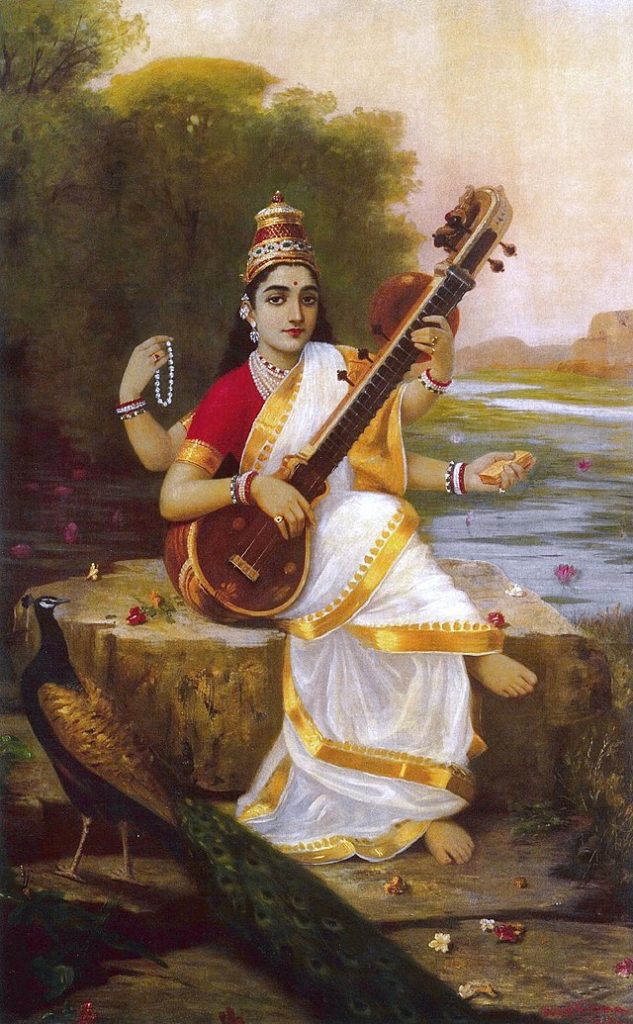 Tales of Devi as Saraswati
Tales of Devi as Saraswati
The first of our stories begins with the very creation of the Universe. After Lord Brahma created the cosmic universe, he realized that his creation lacked forms, concepts, and orders. He was lost and needed assistance. Thus, the goddess Saraswati was born from his mouth as the very embodiment of knowledge to help him with this task. She directed him on how to create order in the cosmos; she orchestrated the birth of the Sun, the Moon, the Stars and the emergence of the the oceans and seasons. Henceforth Saraswati was known as Vagdevi, the Goddess of speech and sound. Brahma and Saraswati became intertwined with Brahma as the creator of the universe and Saraswati as his source of wisdom.
In another tale, a party of demigods that sprang from the fragrance of flowers, known as the Gandharvas, stole the Soma plant from the Devas (gods). The Soma plant was of critical importance to the Devas, as its invigorating sap was thought to be that which granted them immortality. Saraswati promises the Devas that she would recover the Soma without a fight. She managed the feat by entering the garden of the Gandharvas with beautiful music emanating from her veena—nowadays known as the mesmerizing tunes of ragas and the raginis. Completed entranced, the Gandharvas begged for the music to continue. The goddess Saraswati agreed to teach the Gandharvas how to make such sweet melodies in exchange for the safe return of the soma plant. Thus, war and conflict over the soma plant was avoided and the Gandharvas became celestial muscians with the ability to rouse the mind with melodies stronger than every other intoxicant.
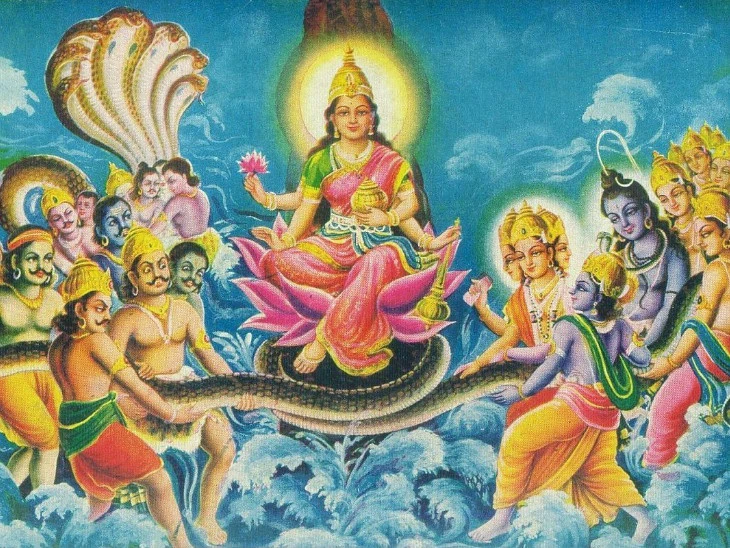
The Birth of Lakshmi: The Churning of the Sea
The story of Lakshmi's birth can be traced back to the encounter of the Deva Indra, the god of Swarga (Heaven), and the Sage Durvasa. In this tale, Durvasa made Indra a famous offering: that of a special garland given to him by a nymph. Indra accepted the garland and placed it on the trunk of Airavata, his elephant. The flowers in the garland were so strong that they attracted some bees; annoyed by the bees, the elephant Airavata tossed his head and threw the garland onto the ground. This act enraged the sage Durvasa, who cursed Indra, claiming the garland to be the dwelling place of Sri (another name for the goddess of fortune, Lakshmi). Durvasa told Indra that the garland was to be treated as Prasada or religious offering; since it had been recklessly thrown on the ground, Indra and the rest of the Devas would now suffer terribly, becoming bereft of all strength, energy, and fortune.
In the battles that followed this curse, the Devas were defeated by the Asuras (the demons); the Asuras, led by Bali, gained control over the Universe. The Devas went to Lord Vishnu, the preserver and protector of the Universe, for aid; Vishnu suggested that the Devas join sides with the Asuras, dealing with them diplomatically. Forming an alliance, the Devas and the Asuras churned the ocean for the nectar of immortality, promising to share it amongst themselves. The churning of the Ocean of Milk was an extensive process in which Mount Mandara, a mountain, was used as the churning rod and Vasuki, a Nagaraja or serpent-like figure that is famed for being coiled around Lord Siva's neck, became the churning rope.
It was from this primeval milky ocean that Lakshmi miraculously appeared, clothed in all white and radiating youth and beauty. It is for this reason that Lakshmi is at times referred to as Ksirabdhitanaya, 'daughter of the sea of milk'. All of the Asuras and Devas wanted to possess Lakshmi; but it was only in the heart of Vishnu that Lakshmi found an equal, a true unconditional love born of divinity and not out of the desire of selfish possession. Because of this, Lakshmi gave herself to Vishnu and was henceforth under his protection as his consort, explaining why Lakshmi is said to dwell on Vishnu's chest and is also referred to as Srinivas, meaning 'the dwelling place of Sri'.



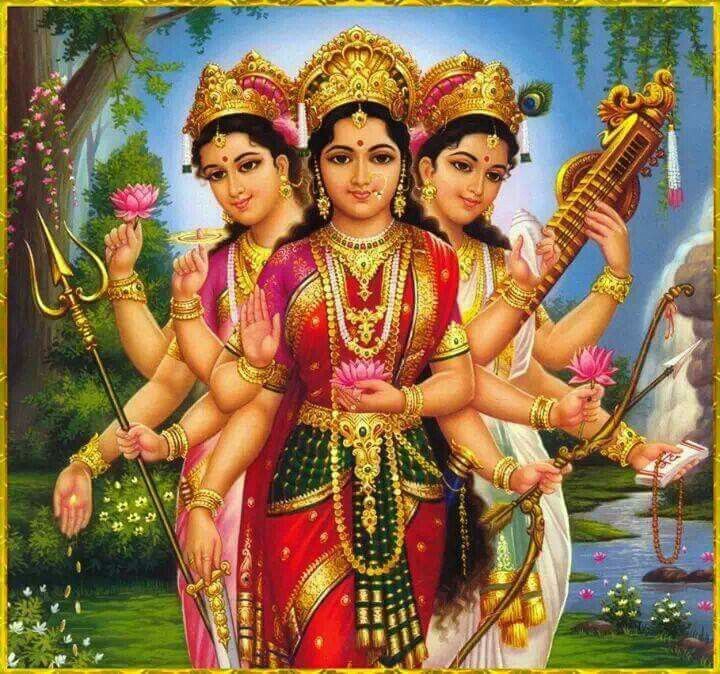
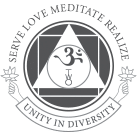




One thought on “Glory to Devi: Exploring the Divine Feminine Through the 3 Aspects of the Divine Mother”
Rukmini Chaitanya
Beautiful blog post. Thank you!